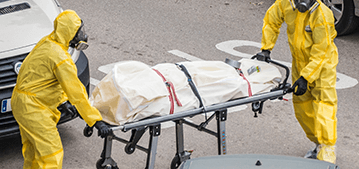Hemorrhages are one of the most common causes of death worldwide

Have you wondered how many deaths occur every year because of uncontrolled bleeding? Did you know hemorrhage is the leading cause of death worldwide? Hemorrhages can be in the form of uncontrolled bleeding after an accident, or controlled bleeding, for example during surgery. Acute bleeding during trauma or surgical interventions often results in unforeseen complications or loss of lives.
Have you wondered how many deaths occur every year because of uncontrolled bleeding? Did you know hemorrhage is the leading cause of death worldwide? Hemorrhages can be in the form of uncontrolled bleeding after an accident, or controlled bleeding, for example during surgery. Acute bleeding during trauma or surgical interventions often results in unforeseen complications or loss of lives.

Coagulation factors IIa, VIIa, IXa and Xa
Coagulation factors IIa, VIIa, IXa, and Xa function in an ancillary way by helping the agar to cross-link with the blood platelets and fibrinogen, thus strengthening the gelatin barrier. Tissue thromboplastin from platelets, which has been activated by damaged cells, assists in forming a clot.
How To Use SeraSeal™
SeraSeal™ is indicated for the control/stopping of (arterial and venous) hemorrhages and parenchymatous organs, seepage bleeding, capillary bleeding, vascular anastomoses etc. occurring in invasive, semi-invasive, and non-invasive procedures. SeraSeal™ is particularly suitable for surgical interventions.
Proven Effectiveness
The effectiveness of SeraSeal™ has been demonstrated in several studies. Even in difficult to control hemorrhages in the gastrointestinal area, bleeding was completely stopped in 87% of patients through the use of SeraSeal™. SeraSeal™ has been demonstrated to minimise blood loss and the necessity for blood transfusions during corrective osteotomies in craniosynostosis surgery.
Seraseal™ supports the body’s own blood coagulation process, acts as a catalyst in the clot formation process, and stops bleeding within 10-30 seconds without the application of pressure. It contains agar, an inert polysaccharide/carbohydrate, and coregulation factors (IIa, VIIa, IXa, and Xa) derived from bovine plasma.
How SeraSeal™ Works
Benefits & Efficacy in Surgery

-
Liver Transplant

Seraseal™ In Liver Transplant Surgery
Injuries can cause bleeding in the front (or anterior chamber) of the eye between the cornea and the iris. This part of the eye holds a clear liquid called aqueous humor.
-
Cosmetic & Reconstructive Surgery

Seraseal™ In Cosmetic And Reconstructive Surgery
- Breast: augmentation, reconstruction, gynecomastia, lift
- Abdomen: abdominoplasty, liposuction
- Head, face, eyes: facelift, nasal surgery, lip augmentation, craniosynostosis
-
Brain & Spine Surgery

Seraseal™ In Brain & Spine Surgery (Seraseal™ Vs Other Conventional Products)
Time to hemostasis is too long for venous bleeds (1-3 minutes), and arterial bleeds (5-10 minutes for small arteries)in conventional products
-
Obstetrics & Gynaecology

Benefits Of Seraseal™ In Obstetrics & Gynaecology
During childbirth, Cesarean section (CS) surgeries, average blood loss has been observed as 500-1500 ml (1-3 units of blood).
-
Gastrointestinal Surgery

Seraseal™ In Gastrointestinal Surgery
Patients with active gastrointestinal bleeding can hugely benefit from Seraseal™ application.
-
Cardiology & Cardiac Surgery

Seraseal™ In Cardiac Sciences
Seraseal™ is a clear and colourless hemostatic agent with a specific gravity of 1.02, which does not obscure the wound.
-
Dialysis

How Seraseal™ Will Benefit Patients On Dialysis
The use of Seraseal™ for the creation of a fistula, graft, or placement of a catheter for dialysis is highly recommended during surgery to control bleeding, rather than cauterization, for Seraseal™ achieves haemostasis without destroying the tissues.
-
Orthopedics & Joint Replacement

Benefits Of Seraseal™ In Orthopedics And Joint Replacement
In a Total Knee Arthroplasty (TKA) there are 3 forms of blood loss: visible blood loss from the surgical field; wound drainage, and blood loss into the tissues (hidden bleeding).

